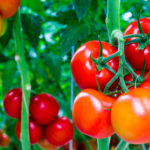In the Garden Blog
Cincinnati's Garden Blog "In the Garden"
Tomato Gardening in Cincinnati: Expert Tips for a Bountiful Harvest
If you’re a Cincinnati gardener, growing tomatoes is likely at the top of your gardening to-do list. Tomatoes thrive in our region when given the proper care, and with the right approach, you can enjoy a bountiful harvest all season long. This guide covers everything you need to know about tomato gardening in Cincinnati, from choosing the best varieties to tackling pests and diseases.
enjoy a bountiful harvest all season long. This guide covers everything you need to know about tomato gardening in Cincinnati, from choosing the best varieties to tackling pests and diseases.
Choosing the Best Tomato Varieties for Cincinnati Gardens
Selecting the right tomato varieties is key to successful tomato gardening in Cincinnati. Our hot, humid summers and occasional cool nights require heat-tolerant, disease-resistant plants. Consider these excellent options:
- Roma Tomatoes: Perfect for sauces, these compact plants fit well in small gardens.
- Beefsteak Tomatoes: Known for large, juicy fruits, these are a classic choice for slicing.
- Cherry Tomatoes: Quick-growing and sweet, varieties like ‘Sun Gold’ are perfect for snacking.
Look for varieties labeled resistant to diseases like fusarium wilt and blight, which are common in Cincinnati gardens.
When to Plant Tomatoes in Cincinnati
Timing is everything for Cincinnati tomato gardening. Tomatoes are warm-season crops and should be planted only after the last frost, typically in mid-May. Starting seeds indoors 6–8 weeks before the last frost gives you a head start.
Pro Tip: Use grow lights or place seedlings near a sunny window to promote healthy growth before transplanting them outdoors.
Preparing Cincinnati Soil for Tomato Gardening
The success of tomato gardening in Cincinnati starts with healthy soil. Our region’s clay soil needs amending to ensure proper drainage and nutrition. Here’s how to prepare your soil:
- Add Compost: Improve soil structure and provide nutrients with compost or aged manure.
- Test the pH: Tomatoes prefer soil with a pH of 6.0–6.8. Soil testing kits are widely available.
- Practice Crop Rotation: Avoid planting tomatoes in the same spot to reduce the risk of diseases.
Caring for Tomatoes in Cincinnati Gardens
Proper care ensures your tomato plants stay healthy and productive. Here are some essential tips for successful tomato gardening in Cincinnati:
- Watering: Water deeply once or twice a week, focusing on the base of the plant to prevent fungal diseases.
- Fertilizing: Start with a balanced fertilizer and switch to a low-nitrogen, high-phosphorus fertilizer once flowers appear.
- Pruning: Remove suckers (small shoots between the stem and branches) to direct energy toward fruit production.
Dealing with Pests and Diseases
Cincinnati’s humid summers can invite a host of pests and diseases. Keep an eye out for these common issues:
- Aphids and Hornworms: Control small infestations by handpicking pests or spraying plants with water and mild dish soap.
- Blight: To prevent fungal diseases, plant tomatoes in full sun, space them properly for airflow, and avoid watering from overhead.
- Cracking and Splitting: Fluctuating moisture levels can cause fruit to crack. Consistent watering will help minimize this problem.
When and How to Harvest Your Tomatoes
This is the moment you’ve been waiting for! Tomatoes are best harvested when fully colored, slightly firm, and fragrant. For indeterminate varieties, pick regularly to encourage more fruit production. If frost threatens, pick unripe tomatoes and let them ripen indoors on a windowsill.
Pro Tip: Want to enjoy fresh tomatoes all year? Freeze or can your harvest to savor the taste of summer long after the season ends.
Start Growing Your Best Tomatoes Today!
Cincinnati gardeners have everything they need to grow amazing tomatoes, from a supportive gardening community to the perfect resources at Natorp’s Nursery. With some planning and care, your garden will burst with flavor in no time.
Have questions or need advice? Natorp grows over 100 kinds of tomatoes. Search our Tomato Library! If you need advice, visit Natorp’s Nursery Outlet or ask an expert today! Together, let’s make this your best tomato season yet!